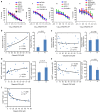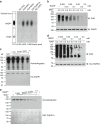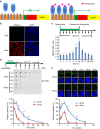NADP+ is an endogenous PARP inhibitor in DNA damage response and tumor suppression
- PMID: 30741937
- PMCID: PMC6370829
- DOI: 10.1038/s41467-019-08530-5
NADP+ is an endogenous PARP inhibitor in DNA damage response and tumor suppression
Abstract
ADP-ribosylation is a unique posttranslational modification catalyzed by poly(ADP-ribose) polymerases (PARPs) using NAD+ as ADP-ribose donor. PARPs play an indispensable role in DNA damage repair and small molecule PARP inhibitors have emerged as potent anticancer drugs. However, to date, PARP inhibitor treatment has been restricted to patients with BRCA1/2 mutation-associated breast and ovarian cancer. One of the major challenges to extend the therapeutic potential of PARP inhibitors to other cancer types is the absence of predictive biomarkers. Here, we show that ovarian cancer cells with higher level of NADP+, an NAD+ derivative, are more sensitive to PARP inhibitors. We demonstrate that NADP+ acts as a negative regulator and suppresses ADP-ribosylation both in vitro and in vivo. NADP+ impairs ADP-ribosylation-dependent DNA damage repair and sensitizes tumor cell to chemically synthesized PARP inhibitors. Taken together, our study identifies NADP+ as an endogenous PARP inhibitor that may have implications in cancer treatment.
Conflict of interest statement
The authors declare no competing interests.
Figures






Similar articles
-
Poly-ADP-ribose polymerases (PARPs) as a therapeutic target in the treatment of selected cancers.Expert Opin Ther Targets. 2019 Sep;23(9):773-785. doi: 10.1080/14728222.2019.1654458. Epub 2019 Aug 13. Expert Opin Ther Targets. 2019. PMID: 31394942 Review.
-
Poly (ADP-Ribose) Polymerases (PARPs) and PARP Inhibitor-Targeted Therapeutics.Anticancer Agents Med Chem. 2019;19(2):206-212. doi: 10.2174/1871520618666181109164645. Anticancer Agents Med Chem. 2019. PMID: 30417796 Review.
-
Coronavirus infection and PARP expression dysregulate the NAD metabolome: An actionable component of innate immunity.J Biol Chem. 2020 Dec 25;295(52):17986-17996. doi: 10.1074/jbc.RA120.015138. Epub 2020 Oct 13. J Biol Chem. 2020. PMID: 33051211 Free PMC article.
-
Poly-ADP ribosylation in DNA damage response and cancer therapy.Mutat Res Rev Mutat Res. 2019 Apr-Jun;780:82-91. doi: 10.1016/j.mrrev.2017.09.004. Epub 2017 Sep 20. Mutat Res Rev Mutat Res. 2019. PMID: 31395352 Free PMC article. Review.
-
Targeting on poly(ADP-ribose) polymerase activity with DNA-damaging hybrid lactam-steroid alkylators in wild-type and BRCA1-mutated ovarian cancer cells.Chem Biol Drug Des. 2017 Nov;90(5):854-866. doi: 10.1111/cbdd.13006. Epub 2017 May 26. Chem Biol Drug Des. 2017. PMID: 28432813
Cited by
-
Classification of stomach adenocarcinoma based on fatty acid metabolism-related genes frofiling.Front Mol Biosci. 2022 Aug 26;9:962435. doi: 10.3389/fmolb.2022.962435. eCollection 2022. Front Mol Biosci. 2022. PMID: 36090054 Free PMC article.
-
PARP Inhibitors: Clinical Relevance, Mechanisms of Action and Tumor Resistance.Front Cell Dev Biol. 2020 Sep 9;8:564601. doi: 10.3389/fcell.2020.564601. eCollection 2020. Front Cell Dev Biol. 2020. PMID: 33015058 Free PMC article. Review.
-
AMPK phosphorylates NAMPT to regulate NAD+ homeostasis under ionizing radiation.Open Biol. 2022 Oct;12(10):220213. doi: 10.1098/rsob.220213. Epub 2022 Oct 5. Open Biol. 2022. PMID: 36196536 Free PMC article.
-
Metabolic Intermediates in Tumorigenesis and Progression.Int J Biol Sci. 2019 May 7;15(6):1187-1199. doi: 10.7150/ijbs.33496. eCollection 2019. Int J Biol Sci. 2019. PMID: 31223279 Free PMC article. Review.
-
Multi-omics analysis reveals distinct non-reversion mechanisms of PARPi resistance in BRCA1- versus BRCA2-deficient mammary tumors.Cell Rep. 2023 May 30;42(5):112538. doi: 10.1016/j.celrep.2023.112538. Epub 2023 May 19. Cell Rep. 2023. PMID: 37209095 Free PMC article.
References
Publication types
MeSH terms
Substances
Grants and funding
LinkOut - more resources
Full Text Sources
Molecular Biology Databases
Research Materials
Miscellaneous

